|
Thursday, Oct. 9
THERE WILL BE NO PHYSICS AND DETECTOR SEMINAR THIS WEEK
2:30 p.m.
Theoretical Physics Seminar
- Curia II
Speaker: Ruth Britto, Fermilab
Title: Unitarity for Loop Amplitudes
3:30 p.m.
DIRECTOR'S COFFEE BREAK - 2nd Flr X-Over
THERE WILL BE NO ACCELERATOR PHYSICS AND TECHNOLOGY
SEMINAR TODAY
Friday, Oct. 10
3:30 p.m.
DIRECTOR'S COFFEE BREAK - 2nd Flr X-Over
4:00 p.m.
Joint Experimental-Theoretical Physics Seminar - One West
Speaker: Thomas Schwarz, University of California, Davis
Title: Measurement of the Top Cross Section at CDF
Click here for NALCAL,
a weekly calendar with links to additional information. |
|
Thursday, Oct. 9
- Santa Fe black bean
- Steak tacos
- Chicken Wellington
- Smart cuisine: spinach enchiladas
- Baked ham & swiss on a ciabatta roll
- Assorted slice pizza
- Crispy fried chicken ranch salad
Wilson Hall Cafe menu |
Thursday, Oct. 9
Dinner
- Closed
Wednedsay, Oct. 15
Lunch
- Beef bourguignon
- Parsley buttered egg noodles
- Apple walnut cake w/cream chantilly
Chez Leon menu
Call x4598 to make your reservation. |
|
|
Fermilab and symmetry breaking
From symmetry breaking, Oct. 8, 2008
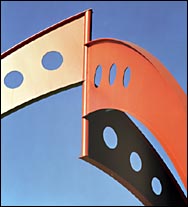
Yoichiro Nambu, Makoto Kobayashi and Toshihide Maskawa won the 2008 Nobel Prize in Physics for their work on symmetry breaking in the world of elementary particles and forces. The prize recognizes the pioneering development of a picture of nature that has had a major impact on physics at Fermilab and at other laboratories around the world. Nambu's formulation of symmetry breaking allows physicists to explain why there is matter in the universe, while the work of Kobayashi and Maskawa provides the theoretical tools to explain why the universe contains no antimatter.
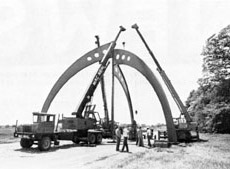
The sculpture "Broken Symmetry" was erected at the Pine Street entrance to Fermilab in 1978.
When physicists discuss symmetries, they refer to things that appear identical. Symmetry breaking is a way of explaining why things look different from each other. An example is gravity. Skaters have no problem gliding in any direction on an ice rink. But if they jump up, gravity pulls them back down. Gravity breaks the symmetry between left and right motion and up and down motion. Every time you jump up, you rediscover gravity through symmetry breaking.
Read more
|
DOE's Dehmer, Kovar win presidential awards
U.S. Department of Energy's Pat Dehmer, deputy director for science programs,
and Dennis Kovar, associate director of science for
high energy physics, earned national recognition for outstanding leadership.
The U.S. Office of Personnel Management announced the 2008 Presidential Rank
Award winners Wednesday.
Kovar was named among the Distinguished Senior Professionals or Executives,
a distinction limited to 1 percent of the senior professionals.
Dehmer was named among the Meritorious Executives and Senior Professionals,
an honor limited to 5 percent of the workforce.
"Winners of the prestigious Presidential Rank Award represent the cream of
the crop within the federal executive ranks," Office of Personnel Management
acting Director Michael Hager said in a statement announcing the 2008
awards. "Their professional dedication and commitment to excellence is
helping to advance President Bush's agenda for enhancing federal government
performance and creating a more effective civil service."
View award recipients
here and here.
|
National Depression Screening Day at Fermilab
At any given time, 10 percent of the adult American population suffers from depression. It is the leading psychological cause for employee absenteeism.
You can find out the difference between sadness and whether you are depressed
on Friday, Oct.10, the 18th annual National Depression Screening Day.
Depression goes unrecognized and untreated up to 80 percent of the time due to social stigma and a lack of symptom recognition. Symptoms include difficulty concentrating, sleep disturbance, irritability and diminishing interest in once-pleasurable activities.
Depression is a medical illness, not a personal weakness. It tends to worsen over time without treatment. People with depression have an imbalance in the brain chemicals serotonin and norepinephrine and often have a family genetic history of depression. Effective treatment can include a combination of medication, talk therapy and regular exercise.
Why wonder if you’re depressed when Fermilab offers a
simple, free assessment process and can help make you feel good again.
Ginny Stack, Fermilab Employee Assistance Program counselor, will offer
confidential assessments beginning on Friday, Oct. 10. You can also take
an online test.
Please contact her at x3591 or vstack@fnal.gov
to schedule your 10-minute screening or to discuss your online test results.
More information
National Institute of Mental Health |

PPD's Victor Martinez took this picture of a sunflower planted earlier this
spring by Bob Kubinski of the DZero mechanical group behind the DZero Assembly
Building.
|
Broken symmetry: Answering the solace of quantum
From AFP, Oct. 7, 2008
Humans like the comfort of symmetry -- the identical image in the mirror, the matching wings of the baroque mansion, the equal numbers in opposing football teams.
So it comes as a bit of a shocker when physicists say the Universe is built on broken symmetry.
Creation was not a soothing, balanced event, they say. It was, essentially, a lopsided affair.
Had things been symmetrical in the Big Bang 13.7 billion years ago, equal amounts of matter and antimatter should have been formed, rather like the hole you dig in the ground is equal to the mound of earth that comes from the hole.
The problem is that matter and antimatter are deadly rivals.
Read more
|
|
|
Expecting the unexpected
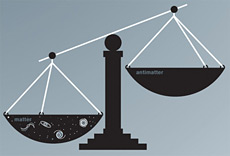
Particle physicists are accustomed to unexpected results and, in 1964, physicists Val Fitch and James Cronin were in for a big surprise. Initially, they were dismayed about an apparent problem with their detector apparatus, which they used to study decays of kaons. Painstaking efforts soon revealed that their detector was fine: They had discovered CP violation, the breaking of a fundamental matter-antimatter symmetry, earning them the Nobel Prize in Physics in 1980. Contributions to this phenomenon earned another three physicists the 2008 Nobel Prize this month.
Like their award winning predecessors, physicists at the Tevatron's DZero
experiment face an uncertainty of their own. Recent
studies of neutral Bs mesons,
which contain a bottom quark and an anti-strange quark, have yielded unexpected
results about the nature of CP violation. The results might indicate the presence
of new physics.
“CP” refers to the product of two symmetries: charge conjugation, which transforms particles into their antimatter form, and parity, which transforms physical systems into their mirror image. Subatomic processes that involve the electromagnetic and strong interactions are invariant under CP transformations. Cronin and Fitch's discovery showed that the weak force does not conserve CP symmetry.
To check their initial Bs results, physicists from the DZero
experiment have constructed a complementary test using semileptonic decays
of neutral Bs mesons, requiring that one of the particles emerging from the decay produces a muon. Not knowing what the outcome will be, these physicists are determined to resolve the conflicting observations and predictions.
By examining the semileptonic decays of neutral Bs mesons, looking
for the signal Bs->X mu Ds, physicists can measure the asymmetry
of the decay by identifying the number of muons with positive and those with negative charge. If there were no CP violation, this asymmetry would be zero. Quantum theories predict the value to be 0.001 percent, and new physics could yield a larger number.
Using 2.8 inverse femtobarns of data, about half the data recorded to date,
DZero physicists measured the asymmetry to be - 0.12 ± 0.56 ( stat ) ± 0.10
(syst) percent. The DZero scientists determined whether the Bs meson was a matter
or an antimatter particle, which allowed them to study the time-dependent evolution
of the Bs mesons. Combining this with techniques used to measure the dimuon charge asymmetry, their work improves upon an earlier DZero result and is the world's most precise direct measurement of this asymmetry.
Physicists aren't yet sure if they should expect new physics or a contradiction with earlier results. More data from the Tevatron will increase the precision of this measurement and help resolve the mystery.
Read more here
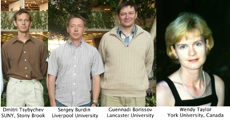
A team of DZero collaborators made primary contributions to this measurement.
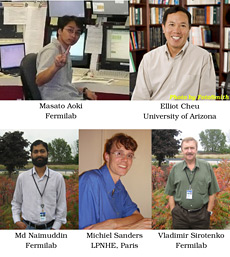
DZero's global monitoring and online
examine support team helped provide the tools needed to make real-time tests of
detector performance. The team's work helps ensure high-quality data for use in
analyses such as the one shown here.
|
|
Have a safe day!
Traffic safety poster contest
The Traffic Safety Subcommittee is sponsoring a traffic
safety poster contest for fourth and fifth grade
students of Fermilab employees, users and contractors. The
posters should promote increased traffic safety awareness.
Entries are due Oct. 31. The contest winner will be announced in
Fermilab Today. The top posters will be displayed in the Wilson Hall atrium. For more information and an entry form, click here.
"The Atom Smashers", panel discussion at Fermilab
Fermilab will show the 78-minute directors' cut of the PBS documentary "The
Atom Smashers," which looks at the race for discovery between Fermilab and CERN. The event
includes a panel discussion with scientists featured in the film, including
Nobel Laureate Leon Lederman. Saturday, October 18, at 7 p.m., in Fermilab's
Ramsey Auditorium. Tickets are $5. For tickets, call (630) 840-2787.
Town hall meeting with future director general of CERN
Fermilab will host an open town hall meeting with Rolf-Dieter Heuer, the
designated director general of CERN, Oct. 28, at 10:45 a.m. in Ramsey
Auditorium, followed by a reception in the WH Art Gallery (2nd floor) at
noon. The town hall meeting includes a 10-minute presentation by Heuer and
a 60-minute Q&A session. Everyone is invited. Heuer would like to meet with
all members of the U.S. particle physics community.
Photos wanted for labwide party
At the labwide party on Oct. 17, a slideshow on the video screen in the
atrium will show images of people at Fermilab. We are looking for additional
photos of you and your colleagues here at work--in your office or work area,
at a department picnic, during lunch in the cafeteria, etc. Please e-mail
your jpeg files to lwp08@fnal.gov by Friday, Oct. 10. Depending on the number
of photos we will receive, we might not be able to include every photo
in the slideshow.
Barn dance Sunday
The Fermilab folk club will host a barn dance Sunday, Oct. 12, in the Kuhn Village Barn at 6:30 p.m. with music by Kit, James & Ericka and calling by Dan Saathoff. Click here for more information.
Additional Activities
|
|